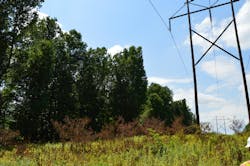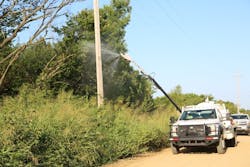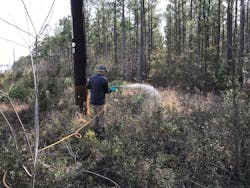A number of potential causes can ignite wildfires, including deserted campfires, discarded cigarettes, automotive accidents and intentional acts of arson. However, studies conducted by the California Department of Forestry and Fire Prevention show nearly 10% of wildfires are caused by electrical power, often leaving utility companies responsible for their devastating effects. The good news is: industry professionals can help mitigate the risk of utility-caused wildfires, as well as subsequent damage to nearby communities and ecosystems, by employing Integrated Vegetation Management (IVM) strategies featuring herbicide applications.
OPTIMIZE WOODY PLANT CONTROL
Trees and other tall-growing plants are the most common causes of utility-ignited wildfires, as they pose an ongoing threat to grow or fall into overhead power lines. Vegetation managers can use a variety of herbicide applications as part of an IVM-based strategy to control incompatible woody plant species and enhance wildfire mitigation efforts. The following application methods can help control incompatible trees and other tall-growing vegetation in the wire zone, which includes all land below wires and conductors, as well as 10 feet beyond their outer edge:
High-volume Foliar
Best suited for the treatment of small trees, vines and bushes, high-volume foliar applications can be applied directly to the foliage of targeted plants after they fully leaf out in the spring. Complete coverage is key to the success of this particular method, which is why targeted plants should be sprayed until all sides are wet.
Key Considerations: High-volume foliar applications are ideal for controlling light-to-moderate brush stands up to 150 plants/acre. While herbicide treatments should always be applied at a rate that aligns with each product label, applying high-volume foliar treatments several weeks after mowing is recommended to ensure adequate regrowth for improved herbicide uptake.
Chemical Side-trim Treatments
Many utility vegetation managers use mechanical mowing or tree-trimming practices to cut entire trees or limbs that threaten electrical transmission reliability. While effective in the short term, this approach to vegetation control stimulates regrowth, which increases maintenance requirements and costs over time, and litters right-of-way (ROW) floors with dry, flammable debris. As opposed to using this less-effective approach to managing incompatible vegetation, industry professionals are encouraged to consider the benefits of chemical side-trim applications.
Instead of hauling wood chippers, trailers and trucks to remove large debris and support equipment following mechanical control methods, utility vegetation managers can selectively apply herbicides to encroaching leaves, limbs and branches by air, from the ground, or via truck-mounted sprayers. When deciduous trees are without foliage during the winter months, herbicide treatments can still be applied to control high-risk limbs and branches.
PROMOTING DESIRABLE PLANT GROWTH
Utility rights-of-way are great locations for fuel break establishment, as they provide large breaks in landscapes and often connect land owned by different entities or communities. Promoting the development of desirable grasses and low-growing plants can effectively transform ROW corridors into effective fuel breaks, which can not only provide a safer environment for firefighters to combat the flames and protect utility infrastructure, but also save lives. Whereas mechanical mowing damages desirable plants, spreads viable seeds and stimulates regrowth for flammable and incompatible plant species, the following herbicide treatments can be used to convert the wire zone, as well as the border zone (all land within 10 feet of a right-of-way) to include beneficial low-growing plant communities:
Low-volume Foliar
To effectively control incompatible woody plants that impede the development of desirable low-growing plant communities, vegetation managers can use backpack sprayers to apply low-volume foliar treatments to individual trees and shrubs that can fuel the spread of wildfire.
Key Considerations: Low-volume foliar applications are recommended for the control of incompatible woody plants up to 8 feet in height. Spray solutions should be applied to thoroughly wet the foliage of target plants after full leaf out, but not to the point of runoff.
Low-volume Basal
Similar to low-volume foliar treatments, low-volume basal applications provide quick and easy control of smaller brush species before they become serious problems. These treatments can be applied at any time of year as long as snow or water do not prevent spraying to the groundline.
Key Considerations: Whereas high- and low-volume foliar applications are applied to the leaves of targeted plants, low-volume basal treatments are only applied to the bark of the trunk. Recommended for stems less than 6 inches in diameter, low-volume basal applications should be sprayed to wet the lower 15 to 20 inches of the trunk, including the root collar. Similar to low-volume foliar treatments, applicators should avoid spraying to the point of runoff.
Other Dormant-season Treatments
A number of herbicide applications can be used to catch up on planned treatment cycles during the dormant season, including dormant-stem and basal cut-stump treatments.Millions of trees and other incompatible plant species line countless miles of utility rights-of-way across the country, leaving vegetation managers with the formidable challenge of protecting as much utility infrastructure as possible each year. Some would argue that complete protection is unachievable, but employing industry best practices, including the impactful control methods listed above, is a great way to not only enhance wildfire mitigation efforts but also environmental sustainability and electrical transmission reliability.
For more information on wildfire mitigation efforts, herbicide products recommended for the control of woody plant species and application success stories throughout the industry, visit VegetationMgmt.com or contact your local Vegetation Management Specialist.
™ ® Trademarks of Corteva Agriscience and its affiliated companies. © 2022 Corteva.
Sponsored By:






